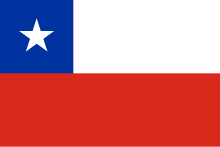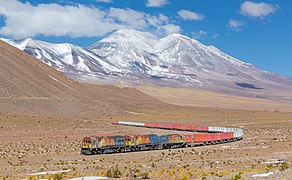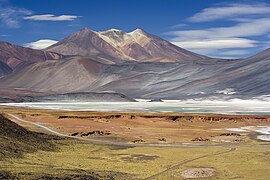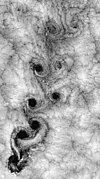
Back بوابة:تشيلي Arabic Portal:Çili Azerbaijani Portal:Chile BAR Portál:Chile Czech Portal:Chile German Portal:Chile Spanish Atari:Txile Basque Portail:Chili French Portalo:Chili IO Portale:Cile Italian
| Main page | Assessment | Articles | Templates | Translation | Noticeboard | To Do List | Portal |
The Chile Portal

Chile, officially the Republic of Chile, is a country in western South America. It is the southernmost country in the world and the closest to Antarctica, stretching along a narrow strip of land between the Andes Mountains and the Pacific Ocean. Chile had a population of 17.5 million as of the latest census in 2017 and has a territorial area of 756,102 square kilometers (291,933 sq mi), sharing borders with Peru to the north, Bolivia to the northeast, Argentina to the east, and the Drake Passage to the south. The country also controls several Pacific islands, including Juan Fernández, Isla Salas y Gómez, Desventuradas, and Easter Island, and claims about 1,250,000 square kilometers (480,000 sq mi) of Antarctica as the Chilean Antarctic Territory. The capital and largest city of Chile is Santiago, and the national language is Spanish.
Spain conquered and colonized the region in the mid-16th century, replacing Inca rule, but failed to conquer the independent Mapuche people who inhabited what is now south-central Chile. Chile emerged as a relatively stable authoritarian republic in the 1830s after their 1818 declaration of independence from Spain. During the 19th century, Chile experienced significant economic and territorial growth, putting an end to Mapuche resistance in the 1880s and gaining its current northern territory in the War of the Pacific (1879–83) by defeating Peru and Bolivia. In the 20th century, up until the 1970s, Chile underwent a process of democratization and experienced rapid population growth and urbanization, while relying increasingly on exports from copper mining to support its economy. During the 1960s and 1970s, the country was marked by severe left-right political polarization and turmoil, which culminated in the 1973 Chilean coup d'état that overthrew Salvador Allende's democratically elected left-wing government. This was followed by a 16-year right-wing military dictatorship under Augusto Pinochet, which resulted in more than 3,000 deaths or disappearances. The regime ended in 1990, following a referendum in 1988, and was succeeded by a center-left coalition, which ruled until 2010.
Chile has a high-income economy and is one of the most economically and socially stable nations in South America, leading Latin America in competitiveness, per capita income, globalization, peace, and economic freedom. Chile also performs well in the region in terms of sustainability of the state and democratic development, and boasts the second lowest homicide rate in the Americas, following only Canada. Chile is a founding member of the United Nations, the Community of Latin American and Caribbean States (CELAC), and the Pacific Alliance, and joined the OECD in 2010. (Full article...)
Socompa is a large stratovolcano at the border of Argentina and Chile with an elevation of 6,051 metres (19,852 ft) metres. Part of the Chilean and Argentine Andean Volcanic Belt (AVB), it is within the Central Volcanic Zone, one of the various segments of the AVB. This part of the Andean volcanic belt begins in Peru and runs first through Bolivia and Chile, and then through Argentina and Chile, and contains about 44 active volcanoes. Socompa lies close to the pass of the same name, where the Salta-Antofagasta railway crosses the border.
Socompa is known for its large debris avalanche, which was formed 7,200 years ago when most of the northwestern slope collapsed and slid down, forming an extensive deposit. It was at first considered to be either a moraine or a nuee ardende deposit, until the 1980 eruption of Mount St. Helens prompted awareness of the instability of volcanic edifices and the existence of large scale collapses on them. The Socompa collapse is among the largest known with a volume of 19.2 cubic kilometres (4.6 cu mi) and covers a surface area of 490 square kilometres (190 sq mi), and its features are well preserved by the arid climate. Notable are the large toreva blocks which were left behind within the collapse crater. After the landslide, the volcano was rebuilt by the effusion of lava flows and much of the scar is now filled in. (Full article...)Selected biography -
Pablo Neruda (/nəˈruːdə/ nə-ROO-də; Spanish pronunciation: [ˈpaβlo neˈɾuða] ; born Ricardo Eliécer Neftalí Reyes Basoalto; 12 July 1904 – 23 September 1973) was a Chilean poet-diplomat and politician who won the 1971 Nobel Prize in Literature. Neruda became known as a poet when he was 13 years old and wrote in a variety of styles, including surrealist poems, historical epics, political manifestos, a prose autobiography, and passionate love poems such as the ones in his collection Twenty Love Poems and a Song of Despair (1924).
Neruda occupied many diplomatic positions in various countries during his lifetime and served a term as a senator for the Chilean Communist Party. When President Gabriel González Videla outlawed communism in Chile in 1948, a warrant was issued for Neruda's arrest. Friends hid him for months, and in 1949, he escaped through a mountain pass near Maihue Lake into Argentina; he would not return to Chile for more than three years. He was a close advisor to Chile's socialist president Salvador Allende, and when he got back to Chile after accepting his Nobel Prize in Stockholm, Allende invited him to read at the Estadio Nacional before 70,000 people. (Full article...)Selected article -

Chilean cuisine stems mainly from the combination of traditional Spanish cuisine, Chilean Mapuche culture and local ingredients, with later important influences from other European cuisines, particularly from Germany, the United Kingdom and France. The food tradition and recipes in Chile are notable for the variety of flavours and ingredients, with the country's diverse geography and climate hosting a wide range of agricultural produce, fruits and vegetables. The long coastline and the peoples' relationship with the Pacific Ocean add an immense array of seafood to Chilean cuisine, with the country's waters home to unique species of fish, molluscs, crustaceans and algae, thanks to the oxygen-rich water carried in by the Humboldt Current. Chile is also one of the world's largest producers of wine and many Chilean recipes are enhanced and accompanied by local wines. The confection dulce de leche was invented in Chile and is one of the country's most notable contributions to world cuisine.
Chilean cuisine shares some similarities with Mediterranean cuisine, as the Matorral region, stretching from 32° to 37° south, is one of the world's five Mediterranean climate zones. (Full article...)General images
Did you know (auto generated)

- ... that Angelito de Canal 13, the mascot of the Chilean television network Canal 13, was inspired by its creator's son?
- ... that Daniela Ceballos worked with the Football Federation of Chile to supervise safety protocols during the COVID-19 pandemic while playing football herself?
- ... that Salar de Pajonales in Chile has been used as an analogue for environments on Mars?
- ... that Salar de Pedernales in Chile features dark slope streaks resembling dark slope streaks on Mars?
- ... that Peruvian foreign minister Manuel María Gálvez Egúsquiza was arrested by Chilean troops for refusing to sign peace with the cession of territory during the War of the Pacific?
- ... that the Peruvian Civil Guard officer Mariano Santos Mateo was nicknamed the Brave Man of Tarapacá because he captured a banner of a Chilean military unit during the Battle of Tarapacá?
Topics
Categories
Recognized content
| This is a list of recognized content, updated weekly by JL-Bot (talk · contribs) (typically on Saturdays). There is no need to edit the list yourself. If an article is missing from the list, make sure it is tagged (e.g. {{WikiProject Chile}}) or categorized correctly and wait for the next update. See WP:RECOG for configuration options. |
Featured articles
- Chilean battleship Almirante Latorre
- Almirante Latorre-class battleship
- Cerro Azul (Chile volcano)
- Calabozos
- El Tatio
- Chilean cruiser Esmeralda (1883)
- Guallatiri
- Hudson Volcano
- Laguna del Maule (volcano)
- Mothers of the Disappeared
- Ojos del Salado
- Pali-Aike volcanic field
- Pisco sour
- South American dreadnought race
- Taapaca
Good articles
- 2010 Pichilemu earthquakes
- 2018 Santiago ePrix
- Agustín Ross Cultural Centre
- Angata
- Los Ángeles Negros
- Apacheta-Aguilucho volcanic complex
- Argentine–Chilean naval arms race
- Atamu Tekena
- Orlando Bosch
- Lorenza Böttner
- Sara Braun
- Monte Burney
- Battle of Caldera Bay
- Felipe Camiroaga
- Chilean battleship Capitán Prat
- Carménère
- José María Caro Martínez
- Chile at the 2014 Winter Paralympics
- Coat of arms of Pichilemu
- Dutch expedition to Valdivia
- El Laco
- El Negrillar
- Milton Friedman
- Fueguino
- Irruputuncu
- Laguna Miscanti
- Laguna del Negro Francisco
- Lascar (volcano)
- Lastarria
- Lazufre
- Licancabur
- Licancabur Lake
- Llullaillaco
- Nevado de Longaví
- Manuel Foster Observatory
- Monturaqui
- Irene Morales
- John Thomas North
- Obligation to Negotiate Access to the Pacific Ocean
- Olca-Paruma
- USS Oneota (1864)
- La Pacana
- Parinacota (volcano)
- Patio 29
- Pichilemu
- Colegio de la Preciosa Sangre de Pichilemu
- Salar de Punta Negra
- Reclus (volcano)
- Murders of María José Reyes and Juan Duarte
- Sammis Reyes
- Riro Kāinga
- Sairecabur
- Salar Ignorado
- San Pedro (Chile volcano)
- Socompa
- Sollipulli
- Tacora
- Tilocálar
- Nevado Tres Cruces
- Tupungatito
- Tuyajto Lake
Featured pictures
-
360-degree Panorama of the Southern Sky edit
-
A 360 degree panorama of a unique cloudscape over La Silla
-
Culpeo MC
-
FCAB EMD GT22CU-3 San Pedro - Ascotan
-
Laguna Miñiques, Chile, 2016-02-08, DD 33-38 PAN
-
Laser Towards Milky Ways Centre
-
Miscanti Lagoon near San Pedro de Atacama Chile Luca Galuzzi 2006
-
Moai Rano raraku
-
SQM GE 289A Boxcab Carmelita - Reverso
-
Volcán San Pedro, Chile, 2016-02-09, DD 18
-
Vortex-street-1
WikiProjects
Related portals
New articles
Rules | Match log | Results page (for watching) | Last updated: 2024-07-18 20:03 (UTC)
Note: The list display can now be customized by each user. See List display personalization for details.
- Ungemachite (edit | talk | history | links | watch | logs | tools) by Shyamal (talk · contribs · new pages (37)) started on 2024-07-18, score: 32
- Chilenocaecilius nestae (edit | talk | history | links | watch | logs | tools) by JarroNevsbaru (talk · contribs · new pages (4)) started on 2024-07-17, score: 23
- Rompecorazones Tour (edit | talk | history | links | watch | logs | tools) by 222 Georgi (talk · contribs · new pages (2)) started on 2024-07-17, score: 14
- El señor de La Querencia (edit | talk | history | links | watch | logs | tools) by Telenovelafan215 (talk · contribs · new pages (4)) started on 2024-07-17, score: 16
- El señor de La Querencia (2024 TV series) (edit | talk | history | links | watch | logs | tools) by Telenovelafan215 (talk · contribs · new pages (4)) started on 2024-07-17, score: 31
- Claudia Salfate (edit | talk | history | links | watch | logs | tools) by ImSnot (talk · contribs · new pages (1)) started on 2024-07-16, score: 43
- Broad Front (Chilean political party) (edit | talk | history | links | watch | logs | tools) by Bedivere (talk · contribs · new pages (7)) started on 2024-07-16, score: 43
- List of 2024–25 Top 14 transfers (edit | talk | history | links | watch | logs | tools) by NikeCage68 (talk · contribs · new pages (1)) started on 2024-07-10, score: 14
- Concentration camp (edit | talk | history | links | watch | logs | tools) by Iskandar323 (talk · contribs · new pages (15)) started on 2024-07-15, score: 14
- Lina Licona (edit | talk | history | links | watch | logs | tools) by Hildreth gazzard (talk · contribs · new pages (196)) started on 2024-07-11, score: 14
- Claudio Reyes (edit | talk | history | links | watch | logs | tools) by Tommy Boy (talk · contribs · new pages (1)) started on 2024-07-14, score: 43
- Eulalio Mora (edit | talk | history | links | watch | logs | tools) by Das osmnezz (talk · contribs · new pages (76)) started on 2024-07-14, score: 23
- Roberto Riveros (edit | talk | history | links | watch | logs | tools) by Das osmnezz (talk · contribs · new pages (76)) started on 2024-07-13, score: 43
- Estadio El Morro (edit | talk | history | links | watch | logs | tools) by Alexisaherven (talk · contribs · new pages (2)) started on 2024-07-13, score: 31
- Marcos Camarda (edit | talk | history | links | watch | logs | tools) by Das osmnezz (talk · contribs · new pages (76)) started on 2024-07-13, score: 23
- Comunal Cabrero (edit | talk | history | links | watch | logs | tools) by Alexisaherven (talk · contribs · new pages (2)) started on 2024-07-13, score: 31
- Chilenocaecilius ornatipennis (edit | talk | history | links | watch | logs | tools) by JarroNevsbaru (talk · contribs · new pages (4)) started on 2024-07-11, score: 23
- 1995–96 in Australian soccer (edit | talk | history | links | watch | logs | tools) by FastCube (talk · contribs · new pages (14)) started on 2024-07-12, score: 18
- Manuel Molina Vélez (edit | talk | history | links | watch | logs | tools) by Mieszkolambert (talk · contribs · new pages (1)) started on 2024-07-11, score: 22
- María José Poncell (edit | talk | history | links | watch | logs | tools) by Jaalvarez7 (talk · contribs · new pages (2)) started on 2024-07-08, score: 63
- Jorge Alfonso (edit | talk | history | links | watch | logs | tools) by BrazilianDude70 (talk · contribs · new pages (44)) started on 2024-07-10, score: 23
- Martín Wainer (edit | talk | history | links | watch | logs | tools) by BrazilianDude70 (talk · contribs · new pages (44)) started on 2024-07-10, score: 23
- Chile, Obstinate Memory (edit | talk | history | links | watch | logs | tools) by Bearcat (talk · contribs · new pages (110)) started on 2024-07-10, score: 31
- Tobías Martins (edit | talk | history | links | watch | logs | tools) by Lachie23 (talk · contribs · new pages (12)) started on 2024-07-09, score: 14
- Gran Hermano (Chilean TV series) season 2 (edit | talk | history | links | watch | logs | tools) by Bbdr16 (talk · contribs · new pages (1)) started on 2024-07-09, score: 28
- Napoléon Louis Eugène Alexandre Anne Emmanuel de Talleyrand-Périgord (edit | talk | history | links | watch | logs | tools) by DACC23 (talk · contribs · new pages (13)) started on 2024-07-08, score: 14
- Renzo Angles (edit | talk | history | links | watch | logs | tools) by HWDPiS (talk · contribs · new pages (3)) started on 2024-07-08, score: 29
- Estudiantes de Santiago del Estero (edit | talk | history | links | watch | logs | tools) by JuanjoAvalos (talk · contribs · new pages (2)) started on 2024-07-08, score: 18
- Mauricio Guidone (edit | talk | history | links | watch | logs | tools) by Jevansen (talk · contribs · new pages (220)) started on 2024-07-08, score: 28
- Sebastián Wolansky (edit | talk | history | links | watch | logs | tools) by Lachie23 (talk · contribs · new pages (12)) started on 2024-07-08, score: 43
- Pamela Brind'Amour (edit | talk | history | links | watch | logs | tools) by Sportsfan 1234 (talk · contribs · new pages (34)) started on 2024-07-07, score: 20
- Dominican Republic at the 2023 Parapan American Games (edit | talk | history | links | watch | logs | tools) by FanOfAvrilOlivia 45 (talk · contribs · new pages (1)) started on 2024-07-07, score: 16
- LI Legislature of the Mexican Congress (edit | talk | history | links | watch | logs | tools) by Moscow Mule (talk · contribs · new pages (139)) started on 2024-07-07, score: 16
- Federico Monja (edit | talk | history | links | watch | logs | tools) by Lachie23 (talk · contribs · new pages (12)) started on 2024-07-05, score: 20
- Juan Catán (edit | talk | history | links | watch | logs | tools) by Lachie23 (talk · contribs · new pages (12)) started on 2024-07-05, score: 20
- Tadeo Marcucci (edit | talk | history | links | watch | logs | tools) by Lachie23 (talk · contribs · new pages (12)) started on 2024-07-05, score: 20
- Lucas Toscani (edit | talk | history | links | watch | logs | tools) by Lachie23 (talk · contribs · new pages (12)) started on 2024-07-05, score: 20
- List of Phi Theta Kappa chapters (edit | talk | history | links | watch | logs | tools) by Rublamb (talk · contribs · new pages (12)) started on 2024-07-05, score: 24
- Bautista Capurro (edit | talk | history | links | watch | logs | tools) by Lachie23 (talk · contribs · new pages (12)) started on 2024-07-05, score: 14
- Gonzalo Manso (edit | talk | history | links | watch | logs | tools) by Jevansen (talk · contribs · new pages (220)) started on 2024-07-05, score: 16
- Franco Cuaranta (edit | talk | history | links | watch | logs | tools) by Jevansen (talk · contribs · new pages (220)) started on 2024-07-05, score: 16
Associated Wikimedia
The following Wikimedia Foundation sister projects provide more on this subject:
-
Commons
Free media repository -
Wikibooks
Free textbooks and manuals -
Wikidata
Free knowledge base -
Wikinews
Free-content news -
Wikiquote
Collection of quotations -
Wikisource
Free-content library -
Wikiversity
Free learning tools -
Wikivoyage
Free travel guide -
Wiktionary
Dictionary and thesaurus
© MMXXIII Rich X Search. We shall prevail. All rights reserved. Rich X Search






















































